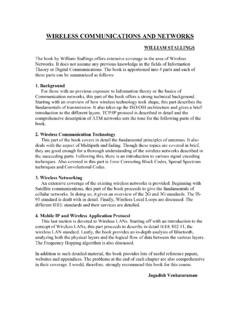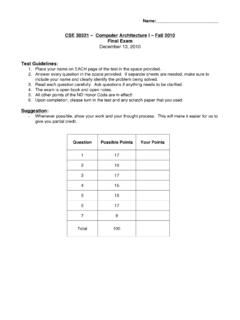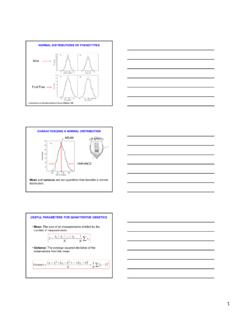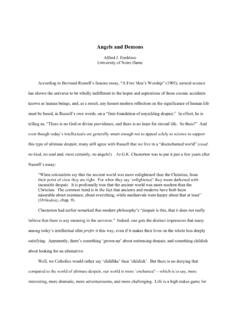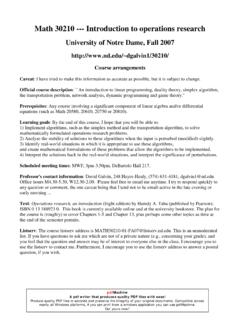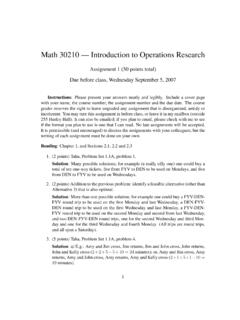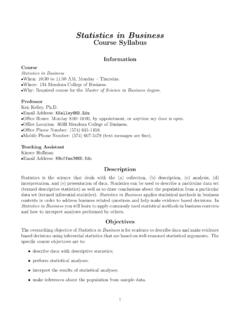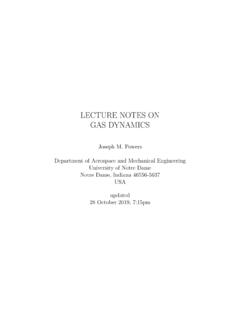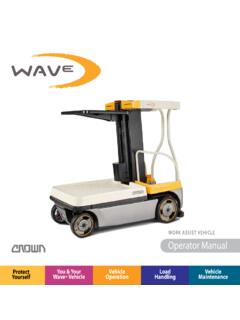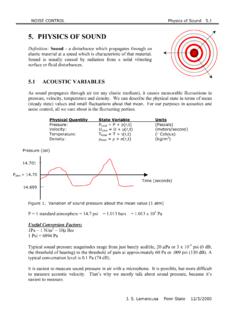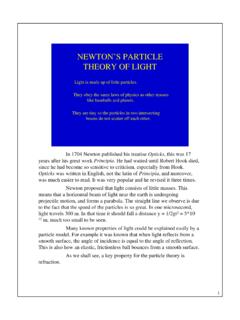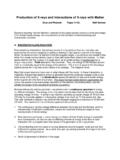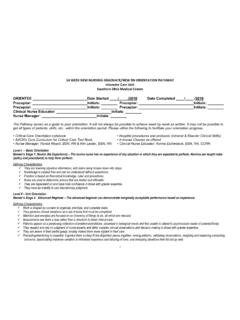Transcription of Introduction to the Mechanics of Waves
1 Introduction to the Mechanics of WavesMihir SenDepartment of Aerospace and Mechanical EngineeringUniversity of Notre Dame, Notre Dame, IN 46556 March 20, 2014iiiic Mihir Sen, 2014 ContentsPreface ..vii1 Introduction12 Wave What is a wave? .. Equations for Waves .. Harmonic Waves .. Solitary Waves .. Shock wave .. Sigmoid wave ..7 Exercises ..83 Properties of Ray tracing .. Dispersion relation .. Energy flow ..9 Exercises ..104 Wave-like Complex wave forms .. Standing Waves .. Damped and growing Waves .
2 Modulated Waves .. Nonlinear Waves ..13 Exercises ..135 Waves in inhomogeneous Slowly-varying media .. Random media ..15 Exercises ..156 Wave First-order equations .. Second-order equations .. Korteweg-de Vries equation .. Fourth-order equations ..20 Exercises ..20iiiCONTENTSiv7 Wave Interior sources .. Boundary sources ..22 Exercises ..228 Harmonic traveling and standing Waves .. Beating .. Refraction .. Reflection .. Interference .. Diffraction .. Doppler effect .. Scattering.
3 23 Exercises ..239 Multi-dimensional waves25 Exercises ..2610 Transverse Waves in a string and String .. Membrane ..27 Exercises ..2711 Elastic Waves in Longitudinal Waves .. Shear Waves .. Thermoelastic Waves ..29 Exercises ..2912 Surface Waves in solids31 Exercises ..3113 Phonons in Single atom type .. Two atom types ..34 Exercises ..3514 Thermal waves37 Exercises ..3715 Water surface Governing equations .. Wave solution .. Special cases ..43 Exercises ..4416 Internal gravity waves45 Exercises ..45ivc Mihir Sen, 2014 CONTENTSv17 Hydraulic jump47 Exercises.
4 4718 Instabilities in Parallel flow .. Kelvin-Helmholtz instability .. Stratified flow ..49 Exercises ..4919 Acoustics in gases51 Exercises ..5220 Shocks in gases53 Exercises ..53A Complex numbers .. Solution of first-order PDE .. Classification of second-order PDEs .. Electromagnetic Waves ..60 Exercises ..60 Index62vc Mihir Sen, 2014 CONTENTS vivic Mihir Sen, 2014 PrefaceThis is a set of notes written for seniors or beginning graduate students in engineering, especiallyfor those in the mechanical sciences like mechanical, chemical, civil, or aerospace engineering.
5 Thematerial can be covered as an Introduction at the beginning of a course on any one of the specializedapplications such as elasticity, acoustics, or water-surface Waves . It is also suitable for self-study byworking engineers or for those for whom a classroom course is not readily available. It is assumedthat the reader has a basic background in undergraduate mathematics including multi-variable andvector calculus, linear algebra, and ordinary differential equations. Knowledge of partial differentialdifferential equations would be a plus, but is not essential since most of the details are included useful background topics are included in the notes emphasize the generic nature of wave theory that is common to most of this relates to the kinematics of Waves and how they travel.
6 For the incorporation of materialparameters and the generation and damping of Waves , however, one has to recur to the dynamicsof the specific physical processes that enables them. In this context physical applications are alsointroduced, more for the purpose of pointing out common features than to enter in depth in eachone, and the reader interested in an application should continue to one of the many specialized bookson each. For this part of the notes, it is assumed that the reader is familiar with undergraduatestatics, dynamics, solid Mechanics , fluid Mechanics , and heat 1 IntroductionHumans have interacted with some form of Waves for a very long time, though of course they werenot known as such.
7 Speech and sound, for example, which enabled communication among ourselvesand the creation of music, date from tens of thousands of years ago. Examples are the acoustics ofamphitheaters1and musical instruments2. However, the science of the subject was really studiedrelatively recently, culminating in classic books like Rayleigh (1877), Lamb (1910) and Jeans (1937).Interaction between temperature differences and sound was discovered by Rijke in 1859, when hefound a way of using heat to sustain a sound in a cylindrical tube open at both is another area that was familiar to the ancients, and its recent history is well contributions were made by Airy, Stokes, and Scott5, among others.
8 Electromagnetismis another field that has made significant contributions to the general theory of Waves . Huygens in1690 explained the behavior of light in terms of Waves , and in 1865 Maxwell was able to calculateits speed from known material properties. This topic, not being a mechanical wave, will only have apassing reference in the Appendix, though its contribution to the fundamental ideas of Waves cannotbe are many kinds of Waves that mechanical engineers deal with. Some of them arein solids and others in liquids and gases; some are on the surface of the material and some in itsinterior.
9 The basic quantity to be studied in a wave, that we will callu, will depend on the physicalapplications. For example, for a water wave it is the instantaneous local height of the water surfaceabove a mean level, and for acoustics it is the instantaneous local pressure. In either caseuis afunction of spacexand Bilsen, Repetition pitch glide from the step pyramid at Chichen Itza,J. Acoustical Society of America,Vol. 120, pp. 594-596, 2006; Declercq and Dekeyser, Acoustic diffraction effects at the Hellenistic amphithe-ater of Epidaurus: Seat rows responsible for the marvelous acoustics,J.
10 Acoustical Society of America,Vol. 121,pp. 2011-2022, Higham, L. Basellb, R. Jacobi, R. Wood, Ramsey, , Testing models for the beginnings of theAurignacian and the advent of figurative art and music: The radiocarbon chronology of Gei enkl osterle,J. HumanEvolution,Vol. 62, pp. 664-676, Rijke, On the vibration of the air in a tube open at both ends,Philosophical Magazine,vol. 17, pp. 419-422, Craik, The Origins of Water Wave Theory,Annual Review of Fluid Mechanics , Vol. 36: 1-28, Russell, 1845, Report on Waves ,Report of the fourteenth meeting of the British Association for the Advance-ment of Science,York, pp.
